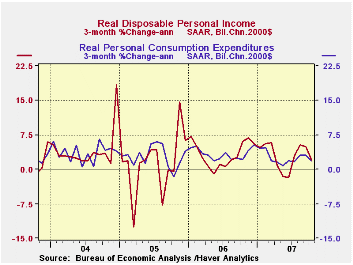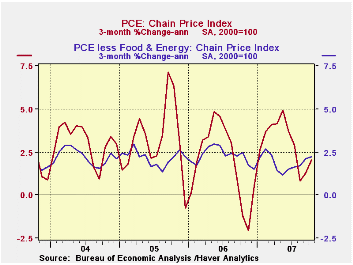 Global| Nov 30 2007
Global| Nov 30 2007U.S. Personal Income Light, Real DPI Down and Real PCE Easier
by:Tom Moeller
|in:Economy in Brief
Summary
Personal income during October rose 0.2% and the increase fell slightly short of Consensus forecasts for a 0.4% gain. The rise followed two months of 0.4% increased it lowered the three month growth in income to 4.3% (AR), its worst [...]

Personal income during October rose 0.2% and the increase fell slightly short of Consensus forecasts for a 0.4% gain. The rise followed two months of 0.4% increased it lowered the three month growth in income to 4.3% (AR), its worst since June.
A shortfall in wages & salaries accounted for much of October's easier income performance with a 0.1% (5.2% y/y) rise after a 0.6% September increase. Three month growth dipped to 4.1%, also the lowest since June. Factory sector wages fell 0.2% (+1.9% y/y) following downwardly revised gains in prior months.Wage & salary income in the private service-producing industries rose a slim 0.1% (6.1% y/y), also after downwardly revised earlier results, and wages in the government sector rose 0.4% (4.5% y/y).
Interest income grew just 0.1% (5.7% y/y) after a 0.6% September rise and dividend income popped another 0.9% (13.0% y/y).
Personal current taxes rose 0.5% (8.6% y/y). As a result, disposable personal income rose only 0.1% (5.7% y/y) but adjusted for inflation, disposable personal income fell 0.2% (+2.7% y/y) after a 0.2% September increase. That left the three month growth in real DPI at 2.1%, its lowest since June.
Personal consumption expenditures rose
0.2% in October and the gain matched expectations. Adjusted for
inflation spending fell very slightly m/m and the three month growth of
1.8% was its weakest since May.
Spending on discretionary items seemed to ease as real spending on motor vehicles fell 0.9% (+2.7% y/y) and spending on household furniture & appliances dropped 0.3% (+7.4% y/y). Spending on apparel was unchanged (+4.2% y/y) and spending on recreation fell 0.3% (+2.5% y/y). These detailed spending figures are available in Haver's USNA database.
The PCE chain price index rose 0.3% and the y/y increase of 2.9% was its quickest since the middle of last year. The core PCE price index gained 0.2%, the same as in September. While y/y growth in core prices has been stable at 1.9%, a pickup to 2.3% (AR) over the last three months does not bode well for overall pricing pressure even given the recent easing of the upward march in oil prices.
Can Social Security Survive the Baby Boomers? from the Federal reserve Bank of St. Louis can be found here.
National and regional economic overview is yesterday's presentation by Fed ChairmanBen S. Bernanke and it is available here.
| Disposition of Personal Income | October | September | Y/Y | 2006 | 2005 | 2004 |
|---|---|---|---|---|---|---|
| Personal Income | 0.2% | 0.4% | 6.0% | 6.6% | 5.9% | 6.2% |
| Personal Consumption | 0.2% | 0.3% | 5.4% | 5.9% | 6.2% | 6.4% |
| Saving Rate | 0.5% | 0.7% | 0.4% (Oct. 06) | 0.4% | 0.5% | 2.1% |
| PCE Chain Price Index | 0.3% | 0.3% | 2.9% | 2.8% | 2.9% | 2.6% |
| Less food & energy | 0.2% | 0.2% | 1.9% | 2.2% | 2.2% | 2.1% |
Tom Moeller
AuthorMore in Author Profile »Prior to joining Haver Analytics in 2000, Mr. Moeller worked as the Economist at Chancellor Capital Management from 1985 to 1999. There, he developed comprehensive economic forecasts and interpreted economic data for equity and fixed income portfolio managers. Also at Chancellor, Mr. Moeller worked as an equity analyst and was responsible for researching and rating companies in the economically sensitive automobile and housing industries for investment in Chancellor’s equity portfolio. Prior to joining Chancellor, Mr. Moeller was an Economist at Citibank from 1979 to 1984. He also analyzed pricing behavior in the metals industry for the Council on Wage and Price Stability in Washington, D.C. In 1999, Mr. Moeller received the award for most accurate forecast from the Forecasters' Club of New York. From 1990 to 1992 he was President of the New York Association for Business Economists. Mr. Moeller earned an M.B.A. in Finance from Fordham University, where he graduated in 1987. He holds a Bachelor of Arts in Economics from George Washington University.






